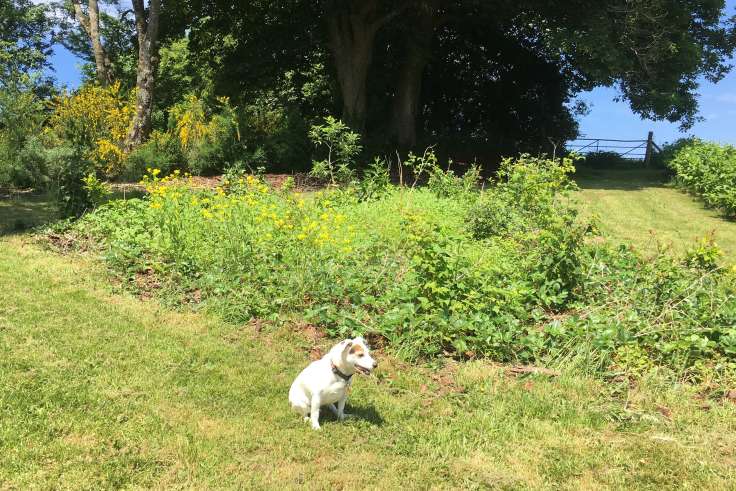
The Fruit Triangle at Forest Garden Wales is less than 40m square but still has 3 distinct layers and permanent ground cover (collar model’s own)
The term “forest garden” can be misleading. It’s neither forest-sized nor a forest, so rest assured that your small garden can be transformed into a forest garden.
One drawback with forest gardening is the name. Firstly, it emulates the edge of a woodland, not the deepest, darkest depths of a forest. And secondly, you most definitely can have a small forest garden, because it’s about the principles rather than the size. The principles are:
- Productive: this means food, possibly twine or canes, and it also applies to plants that support the garden, eg flowers for pollinators & predators, plants for nutrients like comfrey and Broom, and even pretty flowers to encourage the humans outside.
- Multi-layered: the garden is in 3D! This means using all the space, vertically with trees and climbers, a shrub layer and a ground cover. With a small garden, you need to make sure you choose the right-sized tree, which in the case of fruiting trees means a small rootstock, eg an M27 for apples or Gisela 5 for a cherry.
- No-dig permanent ground cover: you want to keep the ground covered and undisturbed as much as possible, as this encourages soil life. There’s a large range of ground cover plants, that don’t need mowing, which you can use for different situations.
- Sustainable: by using mineral accumulator plants for nutrients (and human urine!) you don’t need to apply fertilisers or create compost. Likewise, by encouraging healthy soil, pollinators and predators, you eliminate the need for pesticides. The whole garden is self-sustaining.
- Low maintenance: once the forest garden is established, the majority of the work is harvesting. There is little weeding because of the ground cover, no compost to make unless you’re growing annual vegetables, no mowing unless you have a lawn (and even then, I’d recommend a mini-meadow with paths), no watering unless you have plants in pots.
Because of the name, you’ll find that people call a forest garden a food forest, an edible landscape or even a foodscape!
Whatever you call it, your small garden can be one 🙂.
Shameless plug: I offer a remote forest garden design service